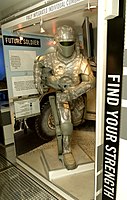
Photo from wikipedia
Abstract Denadai, BS and Greco, CC. Can the critical power model explain the increased peak velocity/power during incremental test after concurrent strength and endurance training? J Strength Cond Res 31(8):… Click to show full abstract
Abstract Denadai, BS and Greco, CC. Can the critical power model explain the increased peak velocity/power during incremental test after concurrent strength and endurance training? J Strength Cond Res 31(8): 2319–2323, 2017—The highest exercise intensity that can be maintained at the end of a ramp or step incremental test (i.e., velocity or work rate at V[Combining Dot Above]O2max − Vpeak/Wpeak) can be used for endurance performance prediction and individualization of aerobic training. The interindividual variability in Vpeak/Wpeak has been attributed to exercise economy, anaerobic capacity, and neuromuscular capability, alongside the major determinant of aerobic capacity. Interestingly, findings after concurrent strength and endurance training performed by endurance athletes have challenged the actual contribution of these variables. The critical power model usually derived from the performance of constant-work rate exercise can also explain tolerance to a ramp incremental exercise so that, Vpeak/Wpeak can be predicted accurately. However, there is not yet discussion of possible concomitant improvements in the parameters of the critical power model and Vpeak/Wpeak after concurrent training and whether they can be associated with and therefore depend on different neuromuscular adaptations. Therefore, this brief review presents some evidence that the critical power model could explain the improvement of Vpeak/Wpeak and should be used to monitor aerobic performance enhancement after different concurrent strength- and endurance-training designs.
Journal Title: Journal of Strength and Conditioning Research
Year Published: 2017
Link to full text (if available)
Share on Social Media: Sign Up to like & get
recommendations!